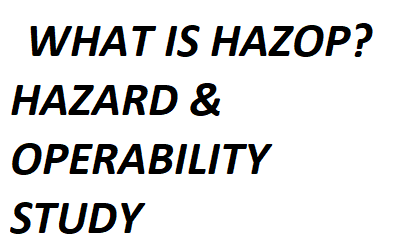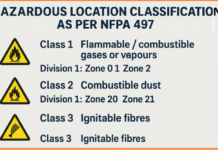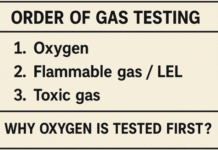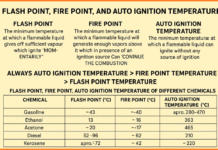Contents
WHAT IS HAZOP?
It is a study that identifies hazard and operability problems by investigating how the plant might deviate from the design.
Definition of HAZOP:-
The application of a formal systematic critical examination to the process and engineering intentions of the new facilities to asses the hazard potential of mal-operation or malfunction of individual items of equipment and the consequential effects on the facility as a whole.
WHY WE NEED HAZOP?
- Chemical Industry handling hazardous substances.
- Manufacturing unit with complex reaction(s).
- Deviations may have serious effects.
- Responsible corporate organization.
- Law abiding company.
- Care for the community in and around the unit.
WHERE did WE need TO APPLY HAZOP?
Limited resources result in the method of selection Factors considered;
- Abnormal occurrences, accidents in the past
- Some study has indicated “High Potential Risk”
- Extensive modification have been done
- Statutory requirement
WHEN HAZOP SHOULD BE DONE?

- Ideally to be done when the design is firm, before construction & startup.
- Technically can be extended to existing plants to improve operating methods.
WHO SHOULD CARRY OUT HAZOP?
Normally to be done by multi-disciplinary teams.
Two types of teams,
- a) Technical contribution
- b) Supporting & structuring role
Should not be too large, ideally 3 to 5 members.
WHO SHOULD CARRY OUT HAZOP?
(a)Technical team
- Chemical,Mechanical,Instrument,Electrical.
- Detailed knowledge of process, plant, equipment.
- The technique of guide words generate questions, that need to be answered without recourse to further expertise.
- (b) Supporting team,
- Someone to control discussion, called ‘Study leader’.
- Guides systematic questioning.
- Should not be closely associated with the subject, danger of developing blind spots.
HOW TO CARRY OUT HAZOP?
Main steps are,
- Define the purpose, objectives, scope of the study.
- Select the team.
- Prepare for the study.
- Carry out the team review.
- Record the results.
Step 1- Define the purpose, objectives, scope:-
- The purpose, objective, the scope should be explained.
- Focus on underlying purpose or reasons.
- Examples of reasons,
- Check the safety of a design.
- Check operating/safety procedures.
- Improve the safety of the existing facility.
- Verify that instrumentation is adequate.
- Define specific consequence to be considered e.g.
- Loss of equipment/production.
- Liability.
- Public safety/Environmental impact.
- If the last one considered, the study should focus on
Deviations which result in off-site hazards.
Step 2- Select the team
- Ideally five persons, one each from one discipline.
- Too large – group approach fails.
- Too small – may lack the breadth of knowledge.
- Members to have knowledge of the process, equip.
Step 3- Prepare for the study
Three steps:
– Drawings (line diagrams, flow sheets, layouts).
– Operating instructions,logic dia, instr.controls.
– Plant manuals, equip manuals, history cards.
- Divide the process into sections with activities.
- Start at the beginning & progressively downstream.
- Establish study nodes(points where temp/press
have identified design intent).
-Apply guide words at specific study nodes.
-Estimate the team hours (Roughly a vessel with
two inlets & two exits, a vent should take 1.5 hrs
or three hrs for each major piece of equip.
-Each session should not last for more than 3 hrs at a stretch.
Step 4- Cont… Important Terminologies
Study nodes: Location at which process parameter is investigated.
Intention: Defines how the plant is expected to operate in the absence of deviations.
Guide word: Simple word to qualify intention to guide, stimulate brainstorming
Deviation: Departure from intention discovered by systematic applying guidewords
Cause: Reason why deviation might occur
Consequence: Result of deviation should it occur
Step 4- Cont… GUIDE WORD APPLICATION
Each guide word is applied to the process variable
Guide words Parameter Deviation
No & Flow No flow
More & Pressure High Pressure
As Well As & One phase Two-phase
Other Than & Operation Maintenance
Step 4- Continued….
- Deviations with cause, the consequence is recorded.
- Two extreme situations,
-A suggested action found for each hazard before
-No search for action until all hazards detected
- If the solution is straightforward, the decision is easy
- The study may expose gaps in information or knowledge of technical team members.
- Thus it may be necessary to call for a specialist.
- Once the section has been examined mark copies.
Step 5- Record results
- Some of the causes may be unrealistic, so derived Consequence will be rejected as not meaningful
- Some of the causes may be trivial hence considered no further.
- Some deviation with both causes that are conceivable & consequences that are potentially hazardous is noted for action.
- The team will make recommendations.
- Some of them require significant changes.
- Clarity needed for responsibility in actions.
- Follow up & ‘Progress chasing’ procedure needed’






Please send any example for HAZOP study for any chemical storage.
Dear Sir
Please send the file
V V V GOOD MATERIAL.THANKS